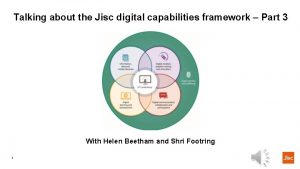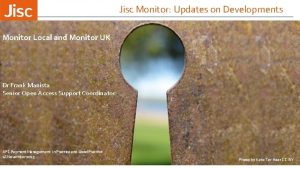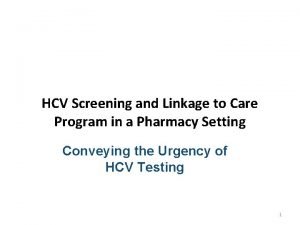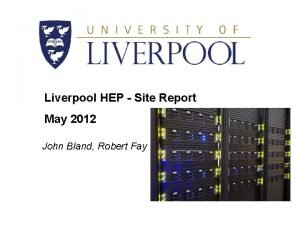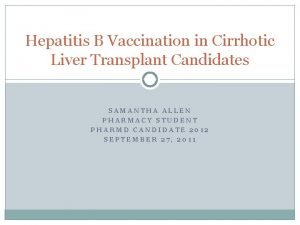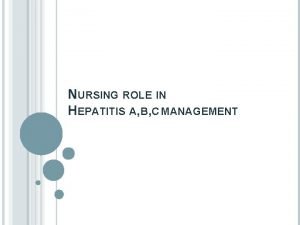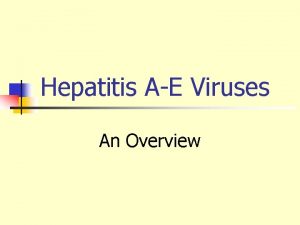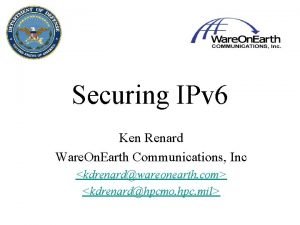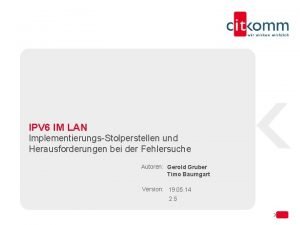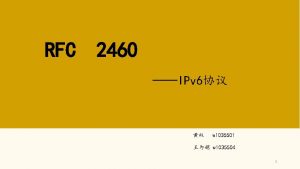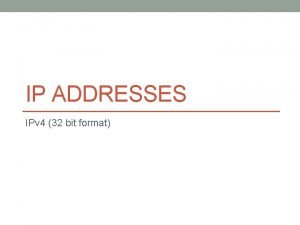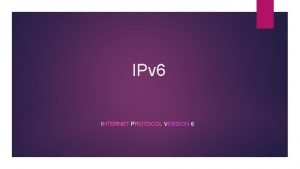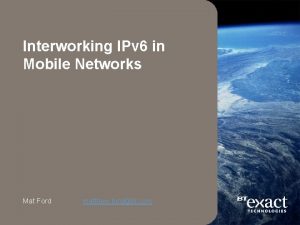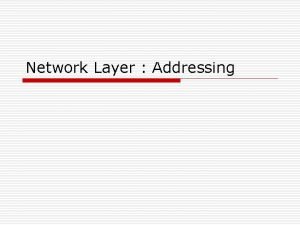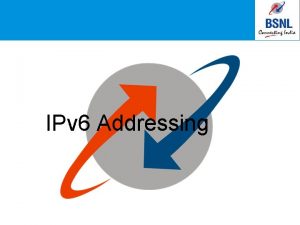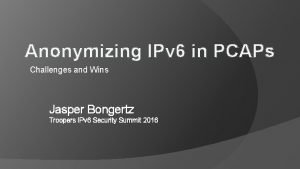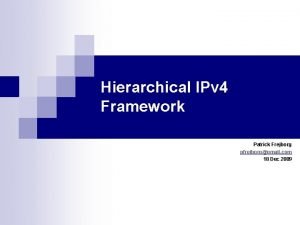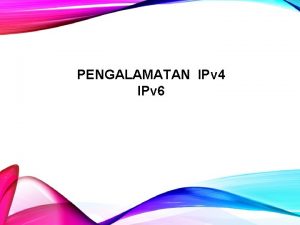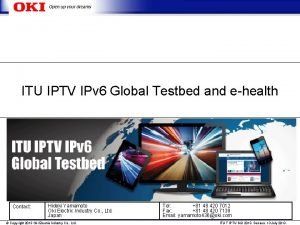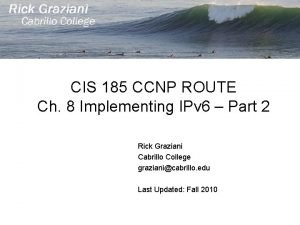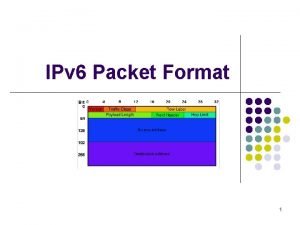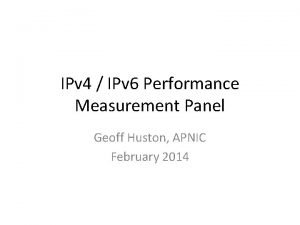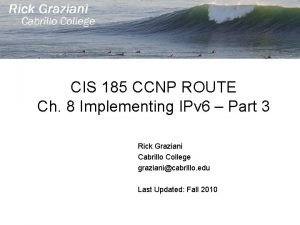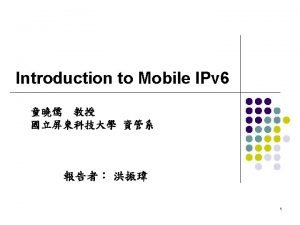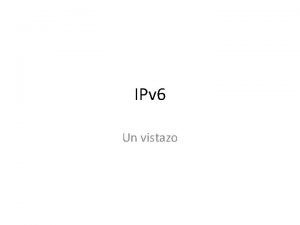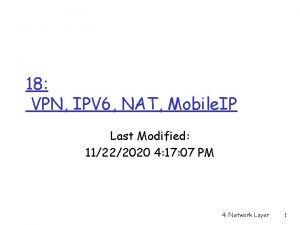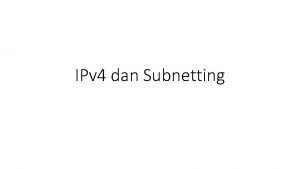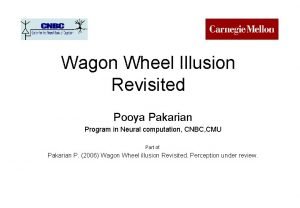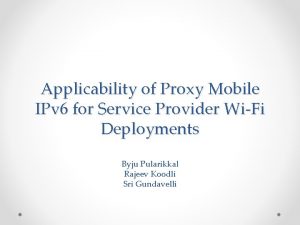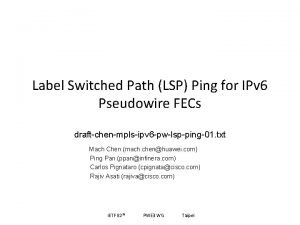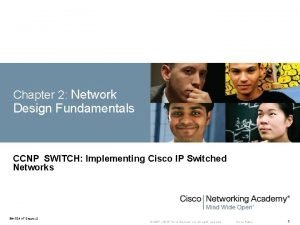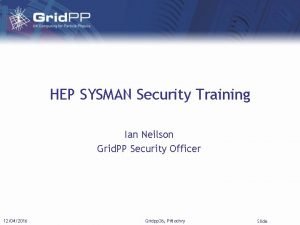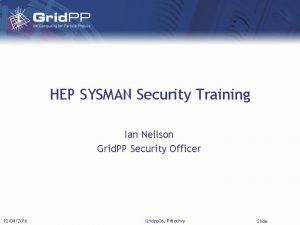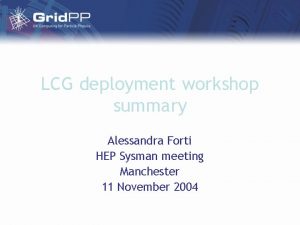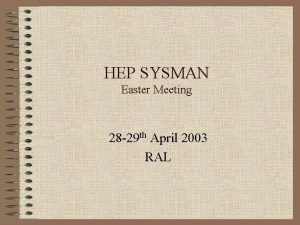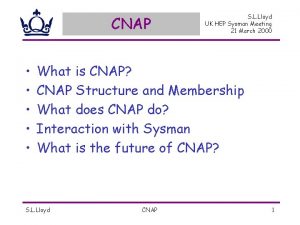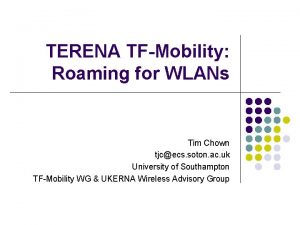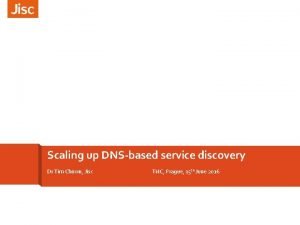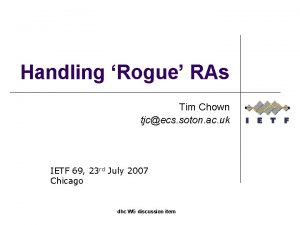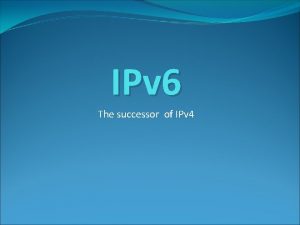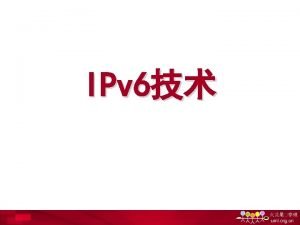IPv 6 Fundamentals Tim Chown Jisc HEP SYSMAN



















































































- Slides: 83

IPv 6 Fundamentals Tim Chown (Jisc), HEP SYSMAN Meeting, RAL, 13 Jun 2017 tim. chown@jisc. ac. uk

IPv 4 status (exhaustion!)

40 years of IP networking » IPv 4 has lasted some 40 years or so » In the 1970’s IP networking was just an ‘experiment’ › A handful of computers taking part » The designers chose to use 32 bits for IPv 4 addresses › 4. 3 billion (2^32) addresses is enough for an experiment, right? › A quite reasonable decision at the time by Vint Cerf and Bob Khan. » IPv 4 address notation was agreed › Addresses written in the ‘dotted quad’ form, e. g. , 192. 0. 2. 1 » Today, with Io. T and other IP growth areas, 32 bits is clearly not enough IPv 6 @ HEPSYSMAN, RAL, 13 June 2017

IPv 4 address space status – exhausted! » The IANA IPv 4 global address pool was exhausted in Feb 2011 › There is no new, unused IPv 4 address space left to give to RIRs » The Regional Internet Registries (RIRs) have varying levels of reserves of address space › APNIC and RIPE NCC are on their last /8, and rationing heavily › ARIN ran out completely in September 2015 » RIPE NCC is using a ‘Last /8’ policy: this means the max IPv 4 allocation is a /22 (1, 024 addresses) › So ISPs (including Jisc) have no new supply of significant address space from their RIR › Jisc can no longer give (say) a /20 to a new university › But existing IPv 4 deployments still work, of course; the sky has not fallen (yet) » See http: //www. potaroo. net and http: //ipv 4. potaroo. net for many, many charts › Excellent resource maintained by Geoff Huston IPv 6 @ HEPSYSMAN, RAL, 13 June 2017

IPv 4 Allocations over time by IANA IPv 6 @ HEPSYSMAN, RAL, 13 June 2017

IPv 4 run-out projection IPv 6 @ HEPSYSMAN, RAL, 13 June 2017

Address exhaustion » What are the impacts of IPv 4 address exhaustion? IPv 6 @ HEPSYSMAN, RAL, 13 June 2017

Impact of IPv 4 address exhaustion? » Includes: › Some organisations may possibly be “encouraged” to return addresses › Increased address space trading/leasing – market at $10/IP or more › Increased use of NAT › › – True end-to-end networking difficult, or impossible – Increased complexity in network management – Accountability issues, potential for overlapping private address space Introduction of Carrier Grade NAT by ISPs – Home DSL router has an ISP-private IP on its ‘public’ interface – Can be recognised by use of reserved 100. 64. 0. 0/10 prefix (RFC 6598) – Likely to have a negative impact on applications, esp. inbound Use of other forms of address sharing – Customers might get an address and a range of port numbers to use IPv 6 @ HEPSYSMAN, RAL, 13 June 2017

IPv 6 Protocols

IPv 6 features? » The solution to IPv 4 exhaustion is IPv 6 » NAT has bought us some time, and is now widely deployed in most home networks, and » many SME and enterprise/campus networks NAT has an adverse effect on network operations, especially end-to-end » But what IPv 6 features or benefits are you aware of already? › Thoughts? IPv 6 @ HEPSYSMAN, RAL, 13 June 2017

IPv 6 features » Key new features of IPv 6 › 128 -bit address space › Host autoconfiguration through “Stateless Address Autoconfiguration” (SLAAC) › SLAAC allows devices to generate their own IP address without a DHCP server » Implicit features › LOTS of addresses – so no need to use host-based NAT » Over-hyped (and not really true…) › Improved Qo. S › Improved security IPv 6 @ HEPSYSMAN, RAL, 13 June 2017

Aside: about IP protocols and standards » The Internet works thanks to use of commonly agreed protocols » The Internet Engineering Task Force (IETF) develops IP-related protocols (amongst other protocols higher up the stack) › Meets three times annually, and uses mail lists › Operates by consensus in Working Groups › Any individual can write an Internet draft › Internet draft documents discussed and progressed if supported through WG › adoption to RFC status if published Now over 8, 000 RFCs published » See http: //www. ietf. org IPv 6 @ HEPSYSMAN, RAL, 13 June 2017

The IPv 6 core protocol » IETF work began in the mid-1990’s on the protocol that became IPv 6 » Led to publication of RFC 2460 in 1998 › This core specification has remained largely unchanged for nearly 20 years – Except for some security-specific updates – Undergoing a (minor) revision this year, largely to include pointers to more recent › and relevant RFCs (see draft-ietf-6 man-rfc 2460 bis-13) Defines header format, including 128 -bit addresses, and packet processing » The IPv 6 address format is defined in RFC 4291 › Describes what the addresses look like › (This RFC has been updated once, and is getting a refresh alongside RFC 2460 -bis) IPv 6 @ HEPSYSMAN, RAL, 13 June 2017

The IPv 6 address format » An IPv 6 address is 128 bits › But how do we write an IPv 6 address? › Using dotted decimals like IPv 4 would be very long! » It was agreed that addresses are written as eight sets of four hexadecimal characters, e. g. › 2001: 0 db 8: 0000: baad: cafe: 1234: 5678 » To abbreviate, you can omit any leading zeros › 2001: db 8: 0: 0: baad: cafe: 1234: 5678 » And you can replace one series of : 0: fields with : : › 2001: db 8: : baad: cafe: 1234: 5678 › … why only one? IPv 6 @ HEPSYSMAN, RAL, 13 June 2017

Example 1… » How can you abbreviate the following IPv 6 address? › 2001: 0 db 8: 0000: 0000: 0 c 50 › A. › B. › C. › D. 2001: 0 db 8: 0: 0: 0 c 50 2001: 0 db 8: : 0 c 50 2001: db 8: : c 5 › (taken from http: //www. ripe. net/lir-services/training/material) IPv 6 @ HEPSYSMAN, RAL, 13 June 2017

Example 2… » How can you abbreviate the following IPv 6 address? › 2001: 0 db 8: 0000: b 450: 0000: 00 b 4 › A. › B. › C. › D. 2001: db 8: : b 450: : b 4 2001: db 8: : b 450: 0: 0: b 4 2001: db 8: : b 45: 0000: b 4 2001: db 8: 0: 0: b 450: : b 4 Note: 2001: db 8: : /32 is the reserved IPv 6 documentation prefix IPv 6 @ HEPSYSMAN, RAL, 13 June 2017

Breaking an address down » IPv 6 allocations are made through the RIRs just as they are (or were!) for IPv 4 › The default IPv 6 allocation to an ISP is a /32 IPv 6 prefix, e. g. Janet has 2001: 630: : /32 › A larger ISP, such as Sky UK, can obtain a larger block of address space » A typical prefix breakdown for a university site might be: IPv 6 @ HEPSYSMAN, RAL, 13 June 2017

Site IPv 6 prefixes » As stated, the default allocation for a site, such as a campus, is a /48 IPv 6 prefix › In practice, a home network may get less, e. g. , a /56 » Such prefixes are Provider Assigned/Aggregated (PA), from the ISP › This means if a customer changes ISP, they will be given a new, different prefix › Which means the customer will have to renumber » RIRs also offer Provider Independent (PI) allocations › These are /48 in size › See https: //www. ripe. net/publications/docs/ripe-684, which describes the policy › Good for customers, but will cause larger global IPv 6 routing tables » Or you can apply to become a Local Internet Registry (LIR), and receive a /32 › QMUL and UCL have done this IPv 6 @ HEPSYSMAN, RAL, 13 June 2017

IPv 6 Address Types » There are two general classes of IPv 6 addresses » Unicast › Same as IPv 4, but with the addition of link-local addresses › More on those in a moment… » Multicast › › › Inherent to the IPv 6 protocols, in particular Neighbour Discovery (ND) (RFC 4861) All multicast addresses fall under ff 00: : /8 IPv 6 does not have an IP subnet broadcast addresses It uses link-local multicast within subnets instead So beware any (very) old hub/switch devices IPv 6 @ HEPSYSMAN, RAL, 13 June 2017

IPv 6 unicast address scopes » Global addresses › Unique globally, routed globally. Just like IPv 4. » Unique Local Addresses (ULAs) (RFC 4193) › › Used within a site, not routed externally Uses reserved prefix under fc 00: : /7 The other prefix bits are random to make a /48 prefix that is probabilistically unique for the site A bit like IPv 4 RFC 1918 private addresses, but not designed to be used with NAT » Link-local addresses › Unique on a subnet, not forwarded by routers › Uses reserved prefix under fe 80: : /10 › A bit like IPv 4 169. 254. 0. 0/16 space (RFC 3927) IPv 6 @ HEPSYSMAN, RAL, 13 June 2017

Multiple IPv 6 addresses per host » So in IPv 6, hosts are usually multi-addressed › Invariably with at least a link-local IPv 6 and a global IPv 6 address » ULAs may be used as well as global addresses › Offers stable internal addressing for a site if your global prefix changes › Devices inside a routed site can prefer to use their ULA addresses › Again, they are NOT designed to be used for IPv 6 NAT » Currently it seems that no universities are using ULAs › Existing IPv 6 deployments use global addresses provided by Jisc » ULAs have been proposed for some uses, e. g. in IPv 6 homenets › The ISP prefix is more likely to change in those scenarios, so internal address stability is desirable IPv 6 @ HEPSYSMAN, RAL, 13 June 2017

Picking addresses: IPv 6 Address Selection » Defined in RFC 6724 › Updates original guidance in RFC 3484 » Used to allow a host to – for example – pick an appropriate source address to use with a given destination address › Match scopes where possible › e. g. it should use a ULA source to talk to a ULA destination › Do not use a link-local source to talk to a global destination (why? ) » However, the multiple address issue is also a challenge for network management and monitoring › Tracking which addresses belong to which devices › Eric will likely mention this later; if not, ask him IPv 6 @ HEPSYSMAN, RAL, 13 June 2017

The loopback address… IPv 6 @ HEPSYSMAN, RAL, 13 June 2017

IPv 6 Neighbour Discovery protocol » IPv 6 employs a suite of protocols known as ‘Neighbour Discovery’, which take the form of either link-local unicast or link-local multicast ICMPv 6 messages » Nodes can send Router Advertisement (RA) messages, to let hosts know about various properties of the link they serve » Nodes can send Router Solicitations to request any routers to send an RA » Neighbour Solicitation (NS) and Neighbour Advertisement (NA) messages provide the equivalent of the IPv 4 ARP function (i. e. , IP to MAC address lookup) » Router Redirects can be sent to a host to tell it about a better first-hop router to get to a destination IPv 6 @ HEPSYSMAN, RAL, 13 June 2017

IPv 6 packet headers » IPv 6 by design streamlines the main IP header › So the IPv 6 header has less fields than the IPv 4 header › The header is also now a fixed size › The header is still longer though, due to the 128 -bit addresses » For additional functions/options, IPv 6 uses optional Extension Headers, inserted by the sender between the main header and the payload › Used when needed, e. g. for fragmentation, or IPsec › So you will see a ‘chain’ of main header, optional headers, then the payload › In most cases, you just see the main header and payload IPv 6 @ HEPSYSMAN, RAL, 13 June 2017

IPv 4 packet header format IPv 6 @ HEPSYSMAN, RAL, 13 June 2017

IPv 6 packet header format IPv 6 @ HEPSYSMAN, RAL, 13 June 2017

IPv 4 compatibility? » IPv 6 is a new IP protocol, with 128 bit addresses » The packet headers are clearly different » IPv 6 is thus not directly compatible with IPv 4 » An IPv 4 -only device therefore cannot send an IPv 4 packet directly to an IPv 6 device » We’ll return to how this issue is handled later on when we look at IPv 6 transition / integration with IPv 4 » Devices can however run both IPv 4 and IPv 6 together (known as dualstack), and then choose which protocol to use IPv 6 @ HEPSYSMAN, RAL, 13 June 2017

More on IPv 6 Extension Headers » Indicated by Next Header field, e. g. : › › › Hop-by-hop header Destination options header Routing header Fragmentation header Authentication and ESP headers » In principle, new Extension Headers can be defined » In practice, firewall implementations can make this problematic, as they drop unknown header types, which new headers will be » Experiments have shown that packets with certain IPv 6 EHs may be dropped by various devices in access networks, or by site firewalls (see RFC 7872) › Not a problem for ‘normal’ traffic IPv 6 @ HEPSYSMAN, RAL, 13 June 2017

Handling fragmentation in IPv 6 » Fragmentation in IPv 6 is only performed by the end hosts › Uses the optional IPv 6 fragmentation header › Fragmentation is not performed by routers in the network » Thus hosts must be able to establish the path MTU › Implies the ICMPv 6 messages used for PMTU discovery must not be filtered › See RFC 4890 for ICMPv 6 filtering recommendations › Don’t just blindly drop all ICMPv 6 traffic at your site border! » IPv 6 links must have an MTU of at least 1280 bytes › For Ethernet, the MTU will usually be 1500 bytes › You may have scenarios where you want to exploit a larger MTU, e. g. 8192 or 9000 IPv 6 @ HEPSYSMAN, RAL, 13 June 2017

Address allocation and management » We’ve seen what IPv 6 packets look like, and the format of an IPv 6 address » We now need methods to › Get allocations of IPv 6 address blocks to use within our site › – As seen earlier, the Janet Service Desk allocates /48 s to Janet-connected sites Decide the method of configuring addresses on hosts in our site IPv 6 @ HEPSYSMAN, RAL, 13 June 2017

Configuring IPv 6 hosts » Given an allocation, there are two choices for configuring hosts › (in addition to manual configuration, if you prefer that) » DHCPv 6 › Largely similar to DHCPv 4 › Familiar model, arguably helps to support accountability › Stateful – the server holds lease information for each address used by a host » Stateless Address Autoconfiguration (SLAAC) › Defined in RFC 4862. New for IPv 6. Allows hosts to essentially pick their own address. › Introduces new management challenges › Still requires stateless DHCPv 6 for additional configuration parameters, e. g. NTP server IPv 6 @ HEPSYSMAN, RAL, 13 June 2017

IPv 6 Autoconfiguration » IPv 6 nodes can use SLAAC to determine their › IP address › Default gateway › (Optionally) DNS resolver » SLAAC works by routers sending link-local multicast Router Advertisement (RAs) » An RA message contains information that may include: › › › On-link prefix(es), with preferred/valid lifetimes The link Maximum Transmission Unit (MTU) ; typically 1500 for Ethernet An indication of the availability of DHCPv 6; M = stateful DHCPv 6 available, O = stateless DHCPv 6 available A-flag; A = 1 means configure address with SLAAC; A = 0 means do not configure address with SLAAC (Optional) DNS resolver information (RFC 8106) IPv 6 @ HEPSYSMAN, RAL, 13 June 2017

RA operation » The Router Advertisement is multicast on the local subnet › Its (link-local) source address implies the default router address › SLAAC works by appending a 64 -bit Extended Unique Identifier (EUI-64) interface identifier to the 64 -bit network prefix to form the host’s 128 -bit IPv 6 address › The EUI-64 interface identifier is formed by taking the 48 -bit MAC address and inserting 16 -bits of padding (‘fffe’) in the middle, and then toggling the ‘universal’ bit. IPv 6 @ HEPSYSMAN, RAL, 13 June 2017

Autoconfiguration example » For example: › Host MAC address = 08: 00: 20: 9 c: 14: 66 › Network prefix = 2001: 630: 80: 2: : /64 › Address = 2001: 630: 80: 2: 0 a 00: 20 ff: fe 9 c: 1466 » Note: › The 48 -bit MAC address requires the 16 -bit ‘fffe’ padding to build a 64 -bit EUI › The universal/local bit is inverted (hence ‘ 0 a’) › Key principle is to form the address by using the prefix from the RA appended with the device’s MAC address (with the padding) to form the 128 -bit IPv 6 host address » SLAAC means all IPv 6 hosts use 64 -bit links; i. e. every host network is a /64 » See RFC 7421 for more discussion of “Why 64 bits? ” IPv 6 @ HEPSYSMAN, RAL, 13 June 2017

Privacy concerns with SLAAC…? » A host autoconfiguring in different visited networks could be traced by its fixed 64 -bit interface identifier (IID) › i. e. , the last 64 bits would be the same wherever the device appeared » So the IETF defined IPv 6 privacy addressing (RFC 4941) › Randomly generate the 64 -bit host part when attaching to a network › And a host may also change its privacy address periodically even if not changing subnets; typically every 24 hours (e. g. , as with MS Windows) » Privacy addresses are good for users, but complicate network management › Which addresses belong to which hosts? › More multi-addressing! IPv 6 @ HEPSYSMAN, RAL, 13 June 2017

Privacy addresses and logging So, how many hosts do you really have? RFC 4941 says you can change your privacy address as little as every 10 minutes IPv 6 @ HEPSYSMAN, RAL, 13 June 2017

Linux configuration example Run ifconfig eth 0 Link encap: Ethernet HWaddr 00: 30: 48: 76: 53: 14 inet addr: 152. 78. 71. 152 Bcast: 152. 78. 71. 255 Mask: 255. 0 inet 6 addr: 2001: 630: d 0: f 110: 230: 48 ff: fe 76: 5314/64 Scope: Global inet 6 addr: fe 80: : 230: 48 ff: fe 76: 5314/64 Scope: Link UP BROADCAST RUNNING MULTICAST MTU: 1500 Metric: 1 RX packets: 795291388 errors: 0 dropped: 0 overruns: 0 frame: 0 TX packets: 710162840 errors: 0 dropped: 0 overruns: 0 carrier: 0 collisions: 0 txqueuelen: 100 RX bytes: 3111500779 (2. 8 Gi. B) TX bytes: 1177068949 (1. 0 Gi. B) IPv 6 @ HEPSYSMAN, RAL, 13 June 2017

Windows configuration example Interface 4: Ethernet: Local Area Connection uses Neighbor Discovery uses Router Discovery link-layer address: 00 -00 -cb-68 -0 b-2 e preferred global 2001: 630: d 0: 112: 309 e: 3 ba 9: d 0 df: 1 afc, life 57 m 25 s/27 m 25 s (temporary) deprecated global 2001: 630: d 0: 112: cc 4 e: 835 c: 7 e 1 b: e 482, life 57 m 25 s/0 s (temporary) deprecated global 2001: 630: d 0: 112: f 4 c 5: 398 e: b 5 f 3: bf 58, life 57 m 25 s/0 s (temporary) deprecated global 2001: 630: d 0: 112: 88 bd: 46 d 0: b 997: 6 dc 4, life 57 m 25 s/0 s (temporary) deprecated global 2001: 630: d 0: 112: e 07 c: fe 6 b: a 58 a: 1608, life 57 m 25 s/0 s (temporary) deprecated global 2001: 630: d 0: 112: b 4 dc: cfc 5: c 6 a 7: 3724, life 57 m 25 s/0 s (temporary) deprecated global 2001: 630: d 0: 112: 1 ca 9: c 9 b: 849 e: 7869, life 57 m 25 s/0 s (temporary) preferred global 2001: 630: d 0: 112: 200: cbff: fe 68: b 2 e, life 57 m 25 s/27 m 25 s (public) preferred link-local fe 80: : 200: cbff: fe 68: b 2 e, life infinite Temporary addresses are IPv 6 Privacy Addresses These change over time – default of a new Privacy Address every 24 hours on Windows A host also has a standard SLAAC-based global IPv 6 address, may be DNS-registered if running services Privacy addresses are only used for initiating connections from a host IPv 6 @ HEPSYSMAN, RAL, 13 June 2017

New: stable, per-prefix Interface IDs » RFC 7217 has recently defined an alternative to MAC-based SLAAC addresses » Still uses the RA for address generation, but no longer appends an EUI-64 » Instead, RFC 7217 generates Interface IDs that are stable for any given visited subnet (i. e. , per /64 network prefix used) › Uses a hashing method on the prefix to build the Interface ID › So you get the same last 64 bits in your address whenever you attach to a subnet using the same prefix, without exposing your MAC address » May be used independently of IPv 6 Privacy Addressing, i. e. typically you would: › Use classic SLAAC, with or without Privacy addresses › Or use RFC 7217 -based SLAAC, with or without Privacy addresses » Windows 10 seems to be using RFC 7217; other OSes likely to follow IPv 6 @ HEPSYSMAN, RAL, 13 June 2017

Using DHCP for IPv 6 » IPv 6 has two variants of DHCPv 6 » Full stateful DHCPv 6 (RFC 3315; currently undergoing a refresh) › Includes IPv 6 address lease support, as per DHCP for IPv 4, i. e. , the DHCPv 6 server › › maintains state on the IPv 6 addresses leased to hosts Supported in common platforms, including the popular ISC DHCP The only exception, unfortunately, is Android – see https: //code. google. com/p/android/issues/detail? id=32621 » Stateless DHCPv 6 (RFC 3736) › For use with SLAAC › Used for additional configuration info only, like NTP server, or search domain IPv 6 @ HEPSYSMAN, RAL, 13 June 2017

DHCPv 6 considerations » DHCPv 6 uses new DHCP Unique Identifiers (DUIDs) › DUIDs aren’t known a priori like Ethernet/MAC addresses › May be a concern if you want to link IP addresses to MAC addresses by DHCP › But there are some large-ish DHCPv 6 deployments out there, e. g. at CERN, for whom this was not a concern » In practice, in an enterprise / campus deployment, clients will speak to a DHCP server via a DHCP relay running on a router › Thus the IETF has introduced RFC 6939 to allow MAC addresses to be › › included as a DHCPv 6 option, and forwarded by DHCPv 6 relays Support demonstrated in Ubuntu, Cisco IOS and ISC DHCP Other platforms following IPv 6 @ HEPSYSMAN, RAL, 13 June 2017

RAs are still required if you use DHCPv 6 » Why? » The RA is the only way a host can learn its default gateway › There is no DHCPv 6 Default Gateway option › DHCPv 6 also has no option for on-link prefix(es) » Therefore all IPv 6 networks must use RAs › And consider their security implications › For example, hosts can send rogue RAs, “accidentally” or maliciously » Note that rogue RAs can also be an issue on “IPv 4 only” networks › More on this from Eric later. . . IPv 6 @ HEPSYSMAN, RAL, 13 June 2017

Addressing on point to point links » There’s been discussion over the prefix length to use for point-to-point › /64, /126 or /127? » Some concerns with using /64 › Address space ‘wasted’ › Possible ‘ping pong’ attacks (packet to an unused address bounces between routers) › Possible ND cache exhaustion attacks » IETF now recommends /127 for point-to-point links › See RFC 6164 › Can still allocate a /64 if you want to though IPv 6 @ HEPSYSMAN, RAL, 13 June 2017

IPv 6 routing » New versions of familiar protocols have been defined › › Multiprotocol BGP (RFC 2545) IS-IS (RFC 5308) OSPFv 3 (RFC 2740) RIPng (RFC 2080) » Most campuses/enterprises probably run OSPFv 2 or IS-IS › Can run OSPFv 2 alongside OSPFv 3 › Note: Various platforms don't support multi-AF OSPFv 3 yet, so using OSPFv 3 › › for both protocols perhaps premature Do request feature parity in procurements though! Opportunity to migrate to IS-IS if not using it IPv 6 @ HEPSYSMAN, RAL, 13 June 2017

Activity: A quick live demonstration A glance at IPv 6 in action IPv 6 @ HEPSYSMAN, RAL, 13 June 2017

A quick IPv 6 hands-on » A quick example… » Using a remote ssh login at Southampton IPv 6 @ HEPSYSMAN, RAL, 13 June 2017

Differences to IPv 4 – a summary

IPv 6 key differences IPv 4 IPv 6 Address length 32 bits 128 bits Prefix length Varies, typically /24 Always /64 in host subnets Address configuration DHCPv 4 Stateless Autoconfiguration DHCPv 6 Addresses used Private or Global Link-local and Global Address resolution ARP Neighbour Solicitation / Advertisement Host Path MTU Discovery Optional Required Fragmentation By hosts or routers Only by hosts Private addressing RFC 1918 Unique Local Addresses (ULAs) (not designed for use with NAT) IPv 6 @ HEPSYSMAN, RAL, 13 June 2017

IPv 4/IPv 6 integration

Scenarios » There are many scenarios where IPv 4/IPv 6 integration tools and solutions are required, e. g. : › A user on a dual-stack host (laptop) on an IPv 4 -only ISP (e. g. a wireless hotspot) wants to access remote IPv 6 services › Connecting IPv 6 networks which only have IPv 4 connectivity between them › An IPv 6 -only system needs to talk to a ‘legacy’ IPv 4 -only system – A realistic scenario on newly deployed access networks – A common scenario on mobile phone networks IPv 6 @ HEPSYSMAN, RAL, 13 June 2017

General approaches » Tunnels / encapsulation › Sending IPv 6 packets over IPv 4 -only infrastructure » Translation › Used between IPv 6 -only and IPv 4 -only nodes › Can be done at application, transport or IP layer › (NAT 64/DNS 64/464 XLAT not covered today – but can discuss if wanted…) » Dual-stack › Instead, choose to run both protocols › Can talk IPv 4 to IPv 4 -only networks and IPv 6 to IPv 6 -only ones › Application chooses which to use, e. g. , based on sorting DNS query responses IPv 6 @ HEPSYSMAN, RAL, 13 June 2017

IPv 6 tunnels over IPv 4 » IPv 6 packets encapsulated as the payload of IPv 4 packets » Typical usage › Connect a user with a dual-stack device on an IPv 4 -only ISP to IPv 6 services (still common) › Connect IPv 6 networks over an IPv 4 path (increasingly rare) » Thus tunnels can be › Host-to-router › Router-to-router » May be set up manually or automatically IPv 6 @ HEPSYSMAN, RAL, 13 June 2017

Tunnel addressing example IPv 6 @ HEPSYSMAN, RAL, 13 June 2017

Manually configured tunnels » Easy to set up and configure » Good management potential › An ISP configures the tunnels, so controls deployment, and is fully aware of customer › › › demand Used historically by on Janet to connect sites running pilots; tunnel from dual-stack site router to Janet tunnel server Jisc now prefers you use the native IPv 6 they deliver to your door I’d assume most Grid. PP sites have native IPv 6 connectivity to Janet » Your users may be interested in IPv 6 access from home or other IPv 4 only networks › This is a scenario served well by tunnel brokers IPv 6 @ HEPSYSMAN, RAL, 13 June 2017

Tunnel brokers » Tunnel brokers have proven quite popular over time › › In Europe the best example is www. tunnelbroker. net Reportedly well over 100, 000 users at its peak Good way to get IPv 6 experience at home, if your ISP lacks IPv 6 support Not for use to connect campus sites » General mode of operation: › › User/client registers with broker service, e. g. via a web page Tunnel requested by user from their IPv 4 address Broker tunnel server sets up its end of the tunnel User/client configures client end of tunnel, e. g. by executing a script IPv 6 @ HEPSYSMAN, RAL, 13 June 2017

Tunnel broker architecture IPv 6 @ HEPSYSMAN, RAL, 13 June 2017

Dual-stack IPv 4/IPv 6 » Already hinted at › Run both protocols on hosts and routers – IPv 6 support is now strong on all mainstream platforms › Let applications/services decide which to use › Aim to allow IPv 4 -only or IPv 6 -only nodes to function fully › A stepping stone to IPv 6 -only operation » Implies › All network/host/application elements support IPv 6 › IPv 6 -capable security components are available › IPv 4 must not be adversely affected – requires IPv 6 functions to be implemented in › hardware as per IPv 4 But this is all very possible today IPv 6 @ HEPSYSMAN, RAL, 13 June 2017

Choosing the protocol » In a dual-stack network the choice of protocol used is application specific › Applications use DNS to resolve names to IP addresses › DNS may return IPv 4 (A) and/or IPv 6 (AAAA) responses › Application may sort these as it wishes, and favour IPv 4 or IPv 6 » If IPv 6 is preferred, you must be confident about the performance / robustness of your IPv 6 connectivity › Users will notice connection issues, evidenced as timeouts before falling back to use IPv 4 › This was a concern a few years ago, but not so valid today – witness all DNS root servers are › now available via IPv 6 Browsers typically implement ”Happy Eyeballs” (RFC 6555) to mitigate poor performance IPv 6 @ HEPSYSMAN, RAL, 13 June 2017

Aside: DNS root servers a. root-servers. net. b. root-servers. net. c. root-servers. net. d. root-servers. net. e. root-servers. net. f. root-servers. net. IN g. root-servers. net. h. root-servers. net. i. root-servers. net. IN j. root-servers. net. IN k. root-servers. net. l. root-servers. net. IN m. root-servers. net. IN IN IN A AAAA IN IN A AAAA A AAAA A AAAA 198. 41. 0. 4 2001: 503: ba 3 e: : 2: 30 192. 228. 79. 201 2001: 500: 84: : b 192. 33. 4. 12 2001: 500: 2: : c 199. 7. 91. 13 2001: 500: 2 d: : d 192. 203. 230. 10 2001: 500: a 8: : e 192. 5. 5. 241 2001: 500: 2 f: : f 192. 112. 36. 4 2001: 500: 12: : d 0 d 128. 63. 2. 53 2001: 500: 1: : 803 f: 235 192. 36. 148. 17 2001: 7 fe: : 53 192. 58. 128. 30 2001: 503: c 27: : 2: 30 193. 0. 14. 129 2001: 7 fd: : 1 199. 7. 83. 42 2001: 500: 3: : 42 202. 12. 27. 33 2001: dc 3: : 35 IPv 6 @ HEPSYSMAN, RAL, 13 June 2017

Translation approaches » Required if you want to access IPv 4 -only content from an IPv 6 -only device › e. g. , in an IPv 6 -only access network » Solutions are NAT 64 / DNS 64 / 464 XLAT › Where DNS is used, a DNS 64 resolver ‘tricks’ a client into believing it’s sending to an IPv 6 destination, by translating the IPv 4 destination into an IPv 6 address › Without DNS (IPv 4 literals), clients can do translation through 464 XLAT » These are widely used by mobile operators › i. e. , people selling real services that depend on it » For EE example in UK, see a UKNOF talk by Nick Heatley: › https: //www. youtube. com/watch? v=l. Kyu. Q 8 mb_GE › https: //indico. uknof. org. uk/event/38/contribution/8/material/slides/1. pdf IPv 6 @ HEPSYSMAN, RAL, 13 June 2017

EE IPv 6 @ HEPSYSMAN, RAL, 13 June 2017

IPv 6 deployment in practice

First - reasons to deploy IPv 6? » What are the drivers for your university to deploy IPv 6? » IPv 4 address space is under pressure, but established universities and research organisations quite commonly have an old Class B /16 IPv 4 address block » They may, or may not, be running short of address space, e. g. for eduroam » Why else might a university/college, or any other organisation, deploy IPv 6? » (In the Grid. PP case, your community has decided IPv 6 is important, but to use it you’ll presumably need support from your university or organisation to deploy it) » Thoughts? IPv 6 @ HEPSYSMAN, RAL, 13 June 2017

Some reasons to deploy » To support teaching and research » Turn on IPv 6 on public-facing servers to simplify the ability of emerging IPv 6 -only » » access networks to communicate with you › And thus avoid translation in the network (NAT 64, etc) To manage IPv 6 as a security measure › All common IP devices have IPv 6 support, and usually on by default Gain experience in IPv 6, to understand how to specify procurement requirements › Even if you don’t plan to turn it on just yet › See http: //www. ripe. net/ripe/docs/ripe-554 for example » To allow deployment of new IPv 6 applications › e. g. true peer-to-peer applications with IPsec (a la Xbox); innovation at the edge » To improve staff / student experience › Bearing in mind that your users will now increasingly have IPv 6 at home IPv 6 @ HEPSYSMAN, RAL, 13 June 2017

Janet and IPv 6 » Janet has been running IPv 6 dual-stack since around 2003 › Undertook first IPv 6 tests in 1996/97 on then ‘ 6 bone’ network » Janet has a /32 from the RIPE NCC › 2001: 630: : /32 › Allocates /48’s from this prefix to organisations, by default › Two sites have a /44 – Oxford and Cambridge, presumably due to their colleges » Various Jisc/Janet services are IPv 6 -enabled › › › Jisc web site – www. jisc. ac. uk - via Cloudflare The. ac. uk DNS service Janet NTP servers eduroam RADIUS peerings … IPv 6 @ HEPSYSMAN, RAL, 13 June 2017

High-level deployment steps? » Preparation: › Arranging IPv 6 connectivity (to Janet) › Getting IPv 6 address space, and forming an IPv 6 address plan › Deciding the scope of your deployment project – Don’t need to do the whole site from day 1 › Audit systems and software for IPv 6 capability; what s/w might need porting? » Deployment: › Enabling IPv 6 on the wire; routing IPv 6 on the core (not exposing IPv 6 to clients initially) › Ensuring security policy is applied; firewalls, IDS › Ensuring network management and monitoring is operational › Configuring supporting services, including DNS › Finally, enabling RAs on LANs where IPv 6 is required; add DNS entries IPv 6 @ HEPSYSMAN, RAL, 13 June 2017

Production deployment – projects? » No need for a full IPv 6 roll-out from day one › Not practical, and not required › UK universities to date are all deploying dual-stack; IPv 6 -only is a future aspiration » Options that a number of universities have used include › › › Public-facing services (e. g. , web presence, DNS servers); see RFC 6883 for advice Wireless network (e. g. , eduroam) Computer Science / research department(s) Computing Service department ‘Science DMZ’ is another emerging use case » In your case, you probably just want to enable your Grid. PP elements › But likely to need deployment in campus core first, whether Science DMZ used or not IPv 6 @ HEPSYSMAN, RAL, 13 June 2017

What is Science DMZ? » It’s a design pattern published by Esnet in 2013 » Principles: 1. Optimise network for science 2. 3. 4. transfers; ‘onramp’ at edge Tune DTN endpoints Measure with perf. SONAR Apply security, efficiently » Then add IPv 6! › Quite a nice, constrained deployment area for a campus IPv 6 @ HEPSYSMAN, RAL, 13 June 2017

Getting an IPv 6 prefix » To deploy, you’ll need an IPv 6 prefix for your site » If your Janet-connected site doesn’t already have a prefix, it’s very easy to get a /48 from Jisc » Send an email to Janet Service Desk › to service@ja. net, or directly to ipaddress@ja. net » They will reply with a username and password for a web form – it’s a fairly simple process » See https: //www. jisc. ac. uk/contact IPv 6 @ HEPSYSMAN, RAL, 13 June 2017

Advice on address planning? » A very good guide available from the RIPE-NCC: › https: //labs. ripe. net/Members/steffann/preparing-an-ipv 6 -addressing-plan » Also see a video of a recent UKNOF talk: › https: //www. youtube. com/watch? v=l. WFc. Ik 4 o. MMU » Lots of ways to be “clever” › e. g. , embed VLAN IDs into the 16 -bits of subnet space » Can choose to plan by topology, or by administrative functions › May just assign a /64 IPv 6 prefix to each existing IPv 4 subnet › Should be able to route prefixes in a typical campus without aggregation › Might for example get a /56 allocated from your campus prefix for use by Grid. PP systems » Other considerations › ULAs (RFC 4193) currently not widely deployed; no evidence of use within UK universities › No need for IPv 6 PI space (or LIR status) for most Janet-connected sites IPv 6 @ HEPSYSMAN, RAL, 13 June 2017

Adding IPv 6 DNS entries » Adding IPv 6 DNS records is similar to IPv 4 › Just add IPv 6 AAAA (‘quad A’) records where you would normally add IPv 4 A records, e. g. $ dig -t any websites 1. ecs. soton. ac. uk. 1800 IN AAAA 2001: 630: d 0: f 104: : 80 e websites 1. ecs. soton. ac. uk. 1800 IN A 152. 78. 189. 43 » You need to arrange and configure forward and reverse DNS delegations › Using the same procedure as for IPv 4 › Reverse DNS sits under ip 6. arpa, using nibble-based delegations IPv 6 @ HEPSYSMAN, RAL, 13 June 2017

Host configuration? » Choices: › Manual address configuration (you may do this now for IPv 4, esp. for servers? ) › Use SLAAC › Use DHCPv 6 » Remember you’ll need to run RAs on the subnet router regardless of use of DHCPv 6 or SLAAC for addresses » In practice, in a typical campus dual-stack network you’ll see: › IPv 4 address by DHCP › IPv 6 address by SLAAC › Other configuration from (IPv 4) DHCP » If you run IPv 6 -only (no IPv 4) then you’ll need at least stateless DHCPv 6 › You may want to explore RFC 8106 (DNS resolver option for RAs) › IPv 6 -only is the end-game; question is at what point it’s practical to deliver › Ideally, don’t really want to be translating high-volume science traffic IPv 6 @ HEPSYSMAN, RAL, 13 June 2017

Other deployment considerations? » ULAs? › Probably no need; just use global addresses › Could use for systems that will never communicate externally › Not designed for IPv 6 NAT » Use of privacy addresses? › Should disable these for non-user systems; helps simplify management » Enabling IPv 6 for a service? › Enable IPv 6 on the system; add DNS entry to ‘advertise’ IPv 6 capability › Ensure all services running on that hostname support IPv 6 before adding the entry » Routing? › Might use static routing for a simple deployment › If using OSPFv 2 for IPv 4, you can run OSPFv 3 alongside for IPv 6, or use multi-AF IPv 4/IPv 6 support in OSPFv 3 IPv 6 @ HEPSYSMAN, RAL, 13 June 2017

Commercial IPv 6 Deployment Activity IPv 6 Deployment Status

IPv 6 deployment » Early IPv 6 adoption was largely by the academic networks » Commercial deployment was, until recently, slower › › Larger UK ISPs now starting to move – Sky was first with over 4 M users enabled, BT now ready See www. ipv 6. org. uk for information on UK IPv 6 deployment; running security workshop on July 12 th UK now at around 20% deployment; Janet sites still under 5% IPv 6 Though some high volume examples, such as approx 40 Gbps IPv 6 achieved by Imperial » Significant ongoing activity by content providers › e. g. Google, Comcast, Facebook, Netflix, Microsoft, and Akamai / Cloudflare CDNs » Measurement examples: › https: //labs. ripe. net/Members/mirjam/content-ipv 6 -measurement-compilation (RIPE NCC) › http: //www. worldipv 6 launch. org/measurements/ (ISOC World IPv 6 Launch site) IPv 6 @ HEPSYSMAN, RAL, 13 June 2017

Google IPv 6 statistics IPv 6 @ HEPSYSMAN, RAL, 13 June 2017

Google stats for UK, late 2015 IPv 6 @ HEPSYSMAN, RAL, 13 June 2017

Google stats for UK, Jun 2017 IPv 6 @ HEPSYSMAN, RAL, 13 June 2017

2013: T-Mobile went IPv 6 -only on Android IPv 6 WAN now uses IPv 6 -only, with NAT 64/DNS 64 IPv 6 @ HEPSYSMAN, RAL, 13 June 2017

2016: IPv 6 is dominant protocol in US mobile IPv 6 @ HEPSYSMAN, RAL, 13 June 2017

Cloud: significant recent progress IPv 6 @ HEPSYSMAN, RAL, 13 June 2017

Commercial IPv 6 Deployment Activity Email: tim. chown@jisc. ac. uk Questions?
 Chown -r username
Chown -r username Jisc collections manager
Jisc collections manager Jisc glassdoor
Jisc glassdoor Jisc digital capabilities framework
Jisc digital capabilities framework Jisc learning analytics
Jisc learning analytics Jisc chicago
Jisc chicago Jisc monitor
Jisc monitor Digimap
Digimap Hep obnovljivi izvori energije
Hep obnovljivi izvori energije Hep a vs b vs c
Hep a vs b vs c Termoelektrana sisak
Termoelektrana sisak Hep c results interpretation
Hep c results interpretation Hep b vaccines
Hep b vaccines Dalmatur
Dalmatur Liverpool hep c
Liverpool hep c Hcv symptoms female
Hcv symptoms female Hep b vaccines
Hep b vaccines Hep b series for adults
Hep b series for adults Hep international
Hep international Nucloplasm
Nucloplasm Lhc forum
Lhc forum Hep b symptoms
Hep b symptoms Hep b mode of transmission
Hep b mode of transmission Ken renard
Ken renard Wwwin.cisco.com
Wwwin.cisco.com Ipv erfahrungen
Ipv erfahrungen Ipv carve out
Ipv carve out Ipv format
Ipv format Ipv format
Ipv format Ipv meaning
Ipv meaning Ipv bits
Ipv bits Ipv allianz
Ipv allianz Rpv ecommerce
Rpv ecommerce Ipv
Ipv Ipv 6
Ipv 6 Ipv 4 terdiri dari... *
Ipv 4 terdiri dari... * Bt smar
Bt smar Ipv 4 terdiri dari... *
Ipv 4 terdiri dari... * Ipv header
Ipv header Ipv finance
Ipv finance Oral-virelon impfung
Oral-virelon impfung Ipv foo
Ipv foo Voith насос voith ipva, ipvap
Voith насос voith ipva, ipvap Frejborg loka
Frejborg loka Relaciona los nombres con las posiciones.
Relaciona los nombres con las posiciones. Ipv format
Ipv format Gt ipv
Gt ipv Route map ipv
Route map ipv Ipv 4 terdiri dari... *
Ipv 4 terdiri dari... * Ipv 4 terdiri dari... *
Ipv 4 terdiri dari... * 6 packet
6 packet Google analz
Google analz Ipv route
Ipv route Ipv route
Ipv route Ipv vs dv
Ipv vs dv Modelo de ipv en cuba
Modelo de ipv en cuba Ipv streaming
Ipv streaming Formato ipv
Formato ipv Ipv format
Ipv format Ipv refresher course
Ipv refresher course Ipv protocol
Ipv protocol Ipv vpn
Ipv vpn Ipv 4 terdiri dari... *
Ipv 4 terdiri dari... * Wagon wheel illusion
Wagon wheel illusion Vaccination dose
Vaccination dose Ipv to psd
Ipv to psd Ipv v4
Ipv v4 Ping ipv
Ping ipv Fundamentals of information systems 9th edition
Fundamentals of information systems 9th edition Electric circuits fundamentals floyd
Electric circuits fundamentals floyd Productivity = output/input
Productivity = output/input Logo design fundamentals
Logo design fundamentals Fundamentals of electric circuits chapter 4 solutions
Fundamentals of electric circuits chapter 4 solutions Cs 1101 programming fundamentals
Cs 1101 programming fundamentals Fundamentals of thermal-fluidsciences chapter 1 problem 16p
Fundamentals of thermal-fluidsciences chapter 1 problem 16p Semiconductor device fundamentals
Semiconductor device fundamentals Mach number in fluid mechanics
Mach number in fluid mechanics Campus network design fundamentals
Campus network design fundamentals The fundamentals of care framework
The fundamentals of care framework Ali sekmen
Ali sekmen Fundamentals of speech recognition
Fundamentals of speech recognition What are neuron processes
What are neuron processes 14 fundamentals of following the prophet
14 fundamentals of following the prophet Android developer fundamentals
Android developer fundamentals



